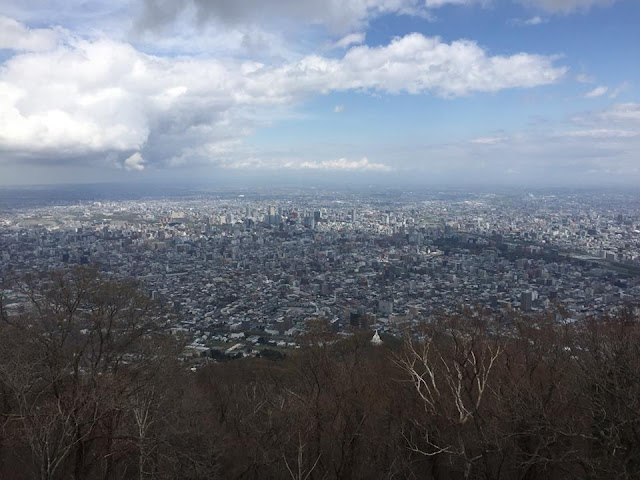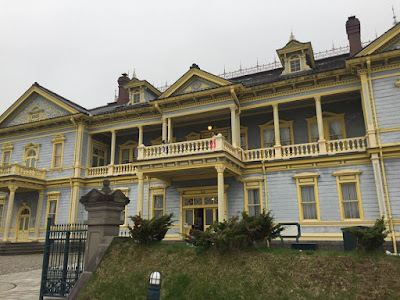Traveling in Japan: Sapporo

My last stop on my Hokkaido trip was its capital city: Sapporo. Sapporo is most widely known for its namesake beer, which is the oldest beer in Japan and the #1 best-selling Japanese beer in the United States, but it has more to offer!
I arrived in Sapporo in the evening, so I waited until the next morning to start exploring. I decided that since the weather was pretty nice, and I had missed my hiking opportunity in Hakodate, that I would do some hiking early on in the morning. My hostel was near Maruyama Park, which has a small 200-meter mountain within its boundaries. As I was walking around the park and looking at some cherry blossom trees early in the morning, I saw that some groups were setting up tarps for picnics on the second to last day of the holiday week. Some of the younger groups were already drinking - possibly continuing the fun from the night before. Others were patiently waiting for the rest of their parties to arrive. The climb up Maruyama afforded some nice views of the city near the top, and after I came back down I walked around the park a bit more and saw that many more people had arrived for picnics. I decided that I had more than enough time to head over to Miowayama - another mountain within walking distance of Maruyama. Miowayama is over 500 meters and it has an optional cable car to the top. I decided to hike up. Having not hiked for the past few months, I could tell I was out of shape, but most of the time it wasn't too bad. There were lots of hikers, all of whom were happy to greet me as I passed.
 After a quick pitstop at my hostel for a shower and a change, I ventured into the center of the city where Odari Park is located. It's long, thin park that stretches for 1.5 km smackdab in the middle of the city. It's a popular place to come to stroll and picnic during the warmer months. In this stretch of greenery and concrete are towers that afford scenic views of the park and the city at large - it's also great for people watching, which I did plenty of. After the park, I walked to the botanical garden which wasn't terribly impressive. Since some parts of Hokkaido still seemed at the cusp of spring, perhaps many of the spring colors were still hiding.
After a quick pitstop at my hostel for a shower and a change, I ventured into the center of the city where Odari Park is located. It's long, thin park that stretches for 1.5 km smackdab in the middle of the city. It's a popular place to come to stroll and picnic during the warmer months. In this stretch of greenery and concrete are towers that afford scenic views of the park and the city at large - it's also great for people watching, which I did plenty of. After the park, I walked to the botanical garden which wasn't terribly impressive. Since some parts of Hokkaido still seemed at the cusp of spring, perhaps many of the spring colors were still hiding.Finally, I made my way to Sapporo Brewery. The Sapporo Brewery has a lot of history. It started in 1876 after a German-trained Japanese brewer returned to Japan. It briefly stopped production during WWII at the behest of the government but has been going strong since post-WWII Japan was established.
Sapporo essentially has its own complex just east of the center of the city. There is a museum (where the old brewery was located) and five restaurants. I visited the restaurant that was supposed to mimic the design of the old German biergartens and ordered Jingisukhan (the Japanese transliteration of "Ghengis Khan"). Jingisukhan is named such because it was believed that the Mongolians preferred to eat lamb. The grill they cook it on also resembles Khan-era Mongolian soldiers' helmets. However, in 1918, the Japanese government took measures to drastically increase the number of sheep in Hokkaido (to kickstart the wool industry, from what I can infer), so the residents started eating a lot of lamb. After lunch, I mosied on over to their Beer Museum which told their story, and then I had three sample-sized beers in their tasting area. One beer in their sample rack is only available in Hokkaido, the Classic Sapporo. Not much different than their regular fare, but it had a bit grassier taste from what I can recall.


 The next day, I had the morning to do what I wanted before my flight later that evening, so I picked up breakfast at a local bakery close to my hostel and wandered through a park a few stops away on the subway line. After breakfast, I decided I had enough time to Moerenuma Park. It was a bit out of the way, but it's striking and sort of alien in a way that reminded me of the public outdoors sculptures in Naoshima. In an effort to create more urban green spaces, the city of Sapporo hired one of Japan's most well-known architects, Isamu Noguchi, to design the project. Sadly, Noguchi right after he finished designing it. It wasn't for another 15 years or so that the park was finished. Besides a few playgrounds for children and soccer and baseball fields, there are two pyramid-shaped hills, a large, triangle-shaped glass building, and a few other oddities. I rented a bike to ride around for an hour or so before I went back into the city in order to catch my flight.
The next day, I had the morning to do what I wanted before my flight later that evening, so I picked up breakfast at a local bakery close to my hostel and wandered through a park a few stops away on the subway line. After breakfast, I decided I had enough time to Moerenuma Park. It was a bit out of the way, but it's striking and sort of alien in a way that reminded me of the public outdoors sculptures in Naoshima. In an effort to create more urban green spaces, the city of Sapporo hired one of Japan's most well-known architects, Isamu Noguchi, to design the project. Sadly, Noguchi right after he finished designing it. It wasn't for another 15 years or so that the park was finished. Besides a few playgrounds for children and soccer and baseball fields, there are two pyramid-shaped hills, a large, triangle-shaped glass building, and a few other oddities. I rented a bike to ride around for an hour or so before I went back into the city in order to catch my flight.



Comments
Post a Comment